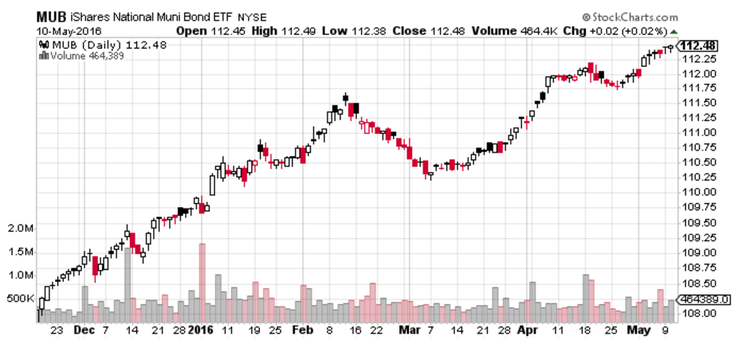
The municipal bond market has been surprisingly robust over the past couple of years.
Municipal revenue has been on the rise thanks to a rebounding economy, while spending has been restrained due to remaining uncertainty. While there have been a few outliers, including Puerto Rico, New Jersey, and Chicago, muni revenues have surpassed the peaks reported prior to the 2008 financial crisis. The only major concerns remaining are long-term in nature, including pension liabilities and rising health care costs.

Investors have flocked into muni bonds in order to offset high tax rates. Since muni bonds aren’t subject to interest taxes, they are a great way for high net worth individuals to increase their after-tax returns. The lack of net issuance has also reduced the supply side of the equation and led to higher prices as investors continue moving into the asset class. Muni bond fund flows surpassed $18 billion during the first quarter of the year and remain strong.
Below, MunicipalBonds.com takes a look at where the opportunities are in today’s market.
Finding the Sweet Spot
The Federal Reserve remains on course to raise interest rates this year, but the number of planned rate hikes has decreased from four to two. The moves would be supported by the addition of 160,000 workers last month and a 2.5% jump in wages compared to a year ago. Traders in the Fed funds futures market are betting on just an 8% chance of a rate hike in June, but a 53% chance of a rate hike by year end.
While a rate hike would have an immediate impact on short-term rates, the effects on the long end of the yield curve are debatable. Higher short-term interest rates may have a slowing effect on the economy and reduce inflationary pressures, which could support long-term bond yields. Investors may want to think twice before avoiding long-term muni bonds in favor of short-term bonds given these dynamics, especially with inflation being so muted.
Intermediate-term muni bonds may present the best opportunities for investors looking for the best of both worlds. By purchasing five- to 15-year muni bonds, investors can capitalize on the steep yield curve without taking on a lot of duration risk. Investors may also want to consider purchasing muni bond funds targeting these terms, since they provide additional benefits in terms of diversification and may reduce overall portfolio risk.
Has High Yield Played Out?
High-yield municipal bonds have become extremely popular over the past several years amid record low interest rates. In today’s environment, investors purchasing these types of bonds may still gain higher income from their investments, but the market’s popularity has eliminated a lot of price appreciation potential. Investors should carefully consider their long-term goals before purchasing these kinds of securities and plan on holding them for the long-term.
High-yield muni bonds returned 5.15% in 2015 and 2.31% during the first quarter of 2016 thanks to the combination of favorable fundamentals, strong investor demand, and limited new issuance. These dynamics have tightened credit spreads to near where they were just before the 2008 financial crisis, while the benefit of going further down the yield curve has diminished. Many taxable equivalents have also seen yields spike thanks to troubled energy firms.
On the other hand, some analysts believe that high-yield muni bonds could see further upside throughout the rest of the year. Rising interest rates could bolster the case for high yield bonds, especially if a rate hike is unexpectedly announced in June. These assets also have a low correlation with other asset classes, which could give them a safe-haven status in the event that the market sees significant volatility over the coming months.
The Bottom Line
The municipal bond market has been extremely robust over the past couple of years thanks to record low interest rates and favorable fundamentals. Looking forward, investors interested in the market may want to consider intermediate-term bonds as a way to hedge their bets against a rate hike, as well as consider their individual situation before investing in high-yield muni bonds.






